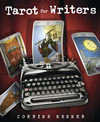Writing Down the Bones: A Writer’s Guide to the Death Card
 Most people fear the Death card. They don't like coming face to face with the Grim Reaper, and they feel nothing but pity for the mortal victims who stand in his path. Writers, however, can recognize a kindred spirit in the card. The Grim Reaper, in fact, is one of their own—and the territory he rides is the familiar battlefield of creation. Study the card closely, and you might even recognize your own dark knight of the soul.
Most people fear the Death card. They don't like coming face to face with the Grim Reaper, and they feel nothing but pity for the mortal victims who stand in his path. Writers, however, can recognize a kindred spirit in the card. The Grim Reaper, in fact, is one of their own—and the territory he rides is the familiar battlefield of creation. Study the card closely, and you might even recognize your own dark knight of the soul.
In most versions of the Death card, the anachronistic specter is a skeletal figure. His bare bones suggest the structure and permanence of the human condition, but he doesn't have the muscle to reveal such raw truths to a wary public. Instead, he's forced to dress his experience in a suit of armor—the artificial construction of a story—to shield his innermost self.
In most versions of the card, the Grim Reaper rides into the scene on the back of an imposing white horse. To the uninitiated, that horse is a hero's mount, and a sign of privilege and acclaim.
While the Grim Reaper is central focus of the Death card, it's interesting to note that he's not actually killing the people gathered at his feet. Granted, one death has occurred, and other deaths seem imminent—but the moment of death itself isn't part of the picture. The Grim Reaper is no wild-eyed murderer. Instead, he plays a role that most writers can also relate to. He's a psychopomp—a mythic conductor of souls, and a guide from this world to the next. In other words, he's the narrator of the story, not a participant. For all practical purposes, writers are psychopomps, too. They are spiritual guides, gently shepherding readers from one series of events to the next. They lead characters and readers alike through a series of transitions, just as the ancient hierophants of ancient Greece would lead their followers through ritual death and rebirth during the annual rites of the Eleusinian Mysteries.
In fact, every symbol in the card is a reminder of the writer's art, as well as humanity's connection to words and story.
The black flag with the five-petaled white rose is connected to more modern secret societies, in which members are initiated through a ritual death and rebirth. Some initiates are even entombed, momentarily, in caskets with white roses painted inside the lid. The five petals represent the five senses—sight, sound, smell, taste, and touch. Good writers incorporate all of five senses in their work, and the Death card makes for a particularly vivid story. Look at the image, and it's not hard to imagine the smell of the rushing river, the sound of the horse's hooves, the taste of blood, or the feel of the freshly plowed field underfoot.
The river in the background alludes to the River Styx, the mythical waterway that separated the land of the living from the land of the dead. In ancient myth, the psychopomp Charon ferried the newly dead from one side to the other. Many of his would-be passengers were buried with gold coins on their eyes or on their tongues, so they would have money to pay their fare.
The two towers in the background represent a gateway to another world, a beginning and an ending, like the covers on a book.
The sun is also a symbol of endings and beginnings. As it rises and sets, it promises rest and reflection, followed by the dawn of a new day.
And, of course, the human figures in the Death card represent a complete cast of characters for any writer. There's a mitered bishop, a symbol of traditional religious authority who still must plead for mercy in the face of certain death. The archetypal doomed king has already lost both his life and his kingdom; his scepter and crown have been cast on the ground, symbols of his lost reign. A child, mystified, watches Death's approach with innocence and wonder; he is too young to fear the unknown. A young maiden, on her knees, seems resigned to her fate. She's been crowned with a ring of flowers, like a sacrificial victim.
They all have a story to tell, and Death's eternal march is the crux of that story. All stories are ultimately about death and rebirth, of character and spirit—and all stories are an exploration of our greatest hopes and fears.
Just as no one can truly experience death and live to tell the tale, we can only come to terms with the concept through story and imagination; writers are our best guides to the other side.
Ultimately, a good story is sacred—as sacred as life and death. In story, words take on a life of their own, and a permanence and form that outlive their creators.

About Corrine Kenner
Related Products

is subject to certain Terms and Conditions